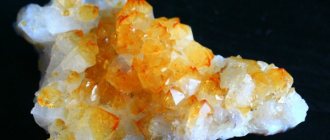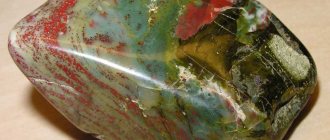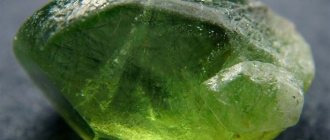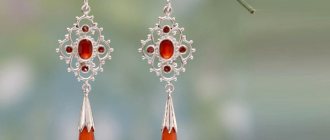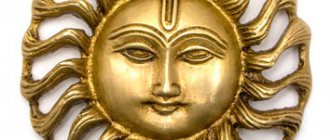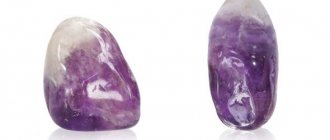Citrine is a yellow stone with a so-called citrus tint.
It belongs to the quartz family, although for a long time it was confused with topaz due to the fact that they are very similar. The gem is loved by jewelers and jewelry lovers. The hardness of the mineral makes it easy to process, and the pretty shade looks equally good with both silver and gold. As a result, buyers are happy to snap up elegant jewelry, replenishing their boxes with them.
Citrine has its own characteristics and secrets. We will share with you all its secrets and tell you who suits citrine according to the horoscope.
Origin of the stone
The golden gem has been known to mankind for a very long time, but it received its known name relatively recently. Historical sources contradict each other, claiming that the citrus name took root either in the 16th or 18th centuries.
In the Middle Ages, a citrine amulet was used to protect against plague and witchcraft.
Before this, citrine was considered topaz, and therefore was called accordingly - Spanish topaz. Sometimes the names “bohemian topaz” or “western topaz” were found. However, people more often called it “the gem of merchants.”
In those days, people believed that this stone could attract wealth. Therefore, merchants used the mineral as a talisman. This is what influenced the appearance of such an unusual unofficial name.
The mineral was held in high esteem in Ancient Greece and Rome. It was considered almost a philosopher's stone; they believed that the gem brings good luck, fame and wealth. Then only rich people wore jewelry with gold stones - merchants, speakers, officials, nobility, but now it is available to almost everyone.
The magical properties of citrine stone have been noticed for a very long time. Ancient peoples healed with the touch of the gem, and in the Middle Ages, citrine was used to protect against plague and witchcraft.
Beautiful citrine stone - the golden kiss of the Sun
The end of summer has come, although the yellow leaves are not yet visible and the sun is shining brightly, soon golden leaves, the first cobwebs, a deep autumn sky will appear, and all this will delight us until the golden autumn. Therefore, to raise morale, we decided to write for you, dear guests and masters of the Masters Fair, an article about such a beautiful and cheerful stone as citrine. Its bright orange-honey color will lift your spirits in any situation, inspire new creative achievements, and when you involuntarily look at a piece of jewelry with citrine, you will immediately forget about everything gloomy and bad, since it will be a personal piece of sunshine.
Citrine is a crystalline variety of quartz with yellow hues, found in the form of well-formed transparent crystals. It is found in hydrothermal formations, sometimes in sedimentary rocks. The name citrine comes from the French "citron" - lemon, or from the Latin word "citrus" - lemon. Citrine crystals are mined in Brazil, Spain, and Madagascar. Small specimens of citrine were found in the vicinity of Jelenia Gora in Poland.
In terms of color characteristics and transparency, citrine is close to topaz, therefore the word “topaz” often appears in the trade names of citrine - Bohemian topaz, Brazilian topaz, oriental topaz, false topaz, pseudotopaz. Golden-yellow citrines are sometimes called golden topaz, and brownish-yellow citrines are sometimes called Spanish topaz. Madeira topaz, bahia topaz, palmyra topaz, and sierra topaz are all trade names for citrine or burnt wine-yellow amethyst from deposits in Brazil. Madagascar citrine is a lemon-yellow topaz from Madagascar. Another ancient name for citrine is saffranitil and its distorted version is safronite (safranite). The name probably comes from the yellow “saffron” color.
The history of this solar quartz dates back to the Middle Ages. The term “citrine” was introduced into mineralogy in 1747 and has been known since 1556. Citrine cabochons can be seen in crowns, rings and other jewelry of rulers of the past, and in the 19th century, jewelry makers used the mineral to make the seals of important gentlemen. Due to the fact that this stone is rare in nature, back in the Middle Ages it was often obtained artificially by burning amethyst crystals.
Citrines acquire different shades from light lemon to intense brown-orange, depending on the proportion of iron impurities in their composition. By subjecting amethysts and some varieties of quartz to heat treatment, it is possible to obtain stones of a rich palette of shades, the most noble of which is called Madeira for the similarity of the shade to the deep and thick color of this type of wine. Stones refined in this way do not have the property of dichromism (they do not change shade depending on the viewing angle), but due to their purity and uniform color they resemble topaz. That is why the market is filled with analogues of the mineral, because the quality of refined stones is in no way inferior to natural ones.
By the color of the stone you can determine the nature of its appearance: the palest ones are real mountain citrines, and the brighter the stone, the more likely it is that it is another burnt quartz, for example, the orange tint is characteristic of singed amethyst. The stone born from nature does not have such an attractive and rich color as fired smoky quartz; transparency predominates in it.
Citrine is a valuable jewelry and collectible mineral; it belongs to IV order precious stones. Citrine is used to make brooches, earrings, pendants, and inserted into rings. In the old days, signet rings were often cut from citrine. For transparent varieties of citrine, diamond or combination cuts are used. For opaque ones - flat, polished stone feed. For stones with moss stains, use only cabochons.
Citrine was used not only as a jewelry insert for jewelry. They have long been used to decorate icons, stained glass windows, and clothes. Jewelry with citrines gained popularity several centuries ago, and still remains one of the favorites of jewelry makers. The material is not very difficult to process and does not require much effort to create a cut. Thanks to the rich kaleidoscope of its delicate colors, this quartz can be combined with absolutely any metal, and is in perfect harmony with other precious stones. The most advantageous option for citrine in a product is, of course, models made of white and yellow gold, and the best partner for inserts in the finished jewelry will be diamonds.
Most citrines that are sold are processed amethysts and smoky quartz. Similarity with them is achieved by calcining the amethyst. 500 degrees, after this treatment citrine has a stable yellow color. Smoky quartz and its varieties turn yellow when heated between 300 and 400 degrees. Citrines with heat treatment have a richer and thicker color, and also have a reddish tint. Natural citrines are usually light or pale yellow.
Jewelers, when choosing what shape and cut to give a stone, primarily focus on the transparency of quartz. If citrines do not contain internal defects or cracks, they are cut like diamonds and used for rings, earrings, brooches, and pendants. If the stone is heterogeneous, then its disadvantages turn into advantages when cut into cabochons and inlaid into bracelets and necklaces.
Larger clear-colored stones are used for brooches and pendants, while smaller quartz stones look great in rings, earrings, bracelets and many other jewelry designs.
This stone has no age restrictions; both young ladies and older ladies can wear jewelry with citrines. The mineral is not striking, but will not go unnoticed in any situation, be it an ordinary day, or some special event where numerous glances will be directed at your person. The stone goes perfectly not only with evening dresses, but will also highlight your individuality with its warmth every day at any time of the year.
Citrine is a stone with a long history and an established noble reputation. People used the mineral as amulets of luck, fertility and harmony. The mineral is the patron of the financial side of life; according to ancient beliefs, the owner of the stone attracted success and financial well-being. Fans of gambling believed that it brought good luck and preferred to wear signet rings to attract good fortune.
Due to its warm, honey-golden color, quartz is considered an object that has absorbed solar energy and eternal life, so everyday things (bracelets, beads) were often decorated with stones in order to maintain the inner harmony of the soul and tranquility of the body. Many speakers and public people had citrine inserts in their outfits and jewelry, so that the stone would help carry the necessary energy from the speaker’s speeches and contribute to the correct flow of thoughts.
Now let's admire the citrine jewelry 
Earrings:
Rings:
Pendants and pendants:
We hope you liked our article and were interested in learning something new for yourself. 
Where is citrine mined?
Citrine is a mineral whose deposits can be found in many countries around the world. The richest deposits are in Brazil, India and Madagascar. The gem is also mined in the USA, France and Scotland.
There are also deposits of citrine in Russia.
In the past, Spain mined citrine on an industrial scale, but soon the reserves were depleted and now there are only crumbs left. The same small volume of crystal is mined in Argentina and Myanmar.
Russia also has deposits of this stone. Its production is carried out in the Urals. It is known that Ural samples ended up in the palace of Catherine II herself.
Physical and chemical properties
Yellow citrine is one of the varieties of quartz. Therefore, the chemical and physical properties of citrine are not too different:
- the stone has a characteristic glassy luster;
- it is transparent;
- above average hardness (7 out of 10 on the mineralogical scale);
- the stones are transparent, but there are opacities in them;
- fade when heated (faded samples become worthless);
- density 2.65 g/cm³.
According to one version, the name of the stone comes from the French “citron”, which means “lemon yellow”. But the color of citrine can be not only lemon - it is many shades of yellow, including the same lemon, honey, amber. This is probably where the second theory came from. According to her, “citrus” means yellow in Latin.
False citrines
Most of the citrines that go on sale are treated amethysts and smoky quartz. The similarity is achieved by calcining the amethyst at a temperature of 500 °C, after which it acquires a stable yellow color. Some varieties of smoky quartz turn yellow when heated to 300–400 °C. All heat-treated stones have a thicker color and a noticeable reddish tint. Natural citrines are usually pale yellow. Citrines heated to a certain temperature do not have pleochroism, and crystals with natural colors show weak pleochroism.
Those. Literally, citrine is an unchanging crystal of natural carcass of yellow color.
What is lemon quartz? Under lemon quartz are hidden false citrines, artificially grown quartz crystals with a yellow color and yellow quartz glasses))).
Application of the mineral
Some precious and semi-precious stones are used in industry, but this is not one of them. The niche of citrine is jewelry making.
The mineral is used in the manufacture of many jewelry:
- rings;
- bracelets;
- beads;
- necklaces;
- pendants;
- brooches;
- hairpin
The mineral is widely used in the jewelry industry.
Among them there are both fairly budget options (small pins, brooches, studs) and expensive sets. The price of citrine depends not only on the number of stones, but also on the metal in which they are framed.
Gold sets will cost more than silver sets. The shape of the decoration also affects the price. A necklace is considered the most elite, but beads are several times cheaper, not to mention bracelets.
Because of its magical properties, citrine has become popular among adherents of esoteric teachings. It is used during magical rituals, for meditation, and also for stone therapy sessions.
How to recognize a fake?
Citrine belongs to class 4, the price is affordable, but it is counterfeited. There are ways to recognize the origin.
- Imitation, unlike most natural crystals, is free of inclusions, clouding, and cracks.
- Citrine, like other unfired quartz, has dichroism, splitting a ray passing through it in two. If the stone was painted, the rays coming out will be different colors.
- Stones imitating citrine are brighter and more brilliant than natural ones.
More often the opposite happens: citrines are sold as emeralds or topazes of similar shades, the price of which is higher. Authenticity is determined in a laboratory. There are doublets consisting of emerald and quartz glued together. Upon careful inspection, bubbles are visible at the junction.
We recommend reading: Sardonyx is a stone of youth and longevity, for whom it suits according to the horoscope
Caring for citrine products
Most jewelry lovers are not familiar with jewelry making. Knowing nothing about caring for jewelry, they make irreparable mistakes.
Do not use aggressive chemicals to clean items with stones.
To prevent you from ruining your favorite talisman, we will share tips on how to wear citrine:
- The stone can fade in the sun. When heading to the beach, leave your favorite jewelry at home.
- All kinds of chemicals used when cleaning the premises are very dangerous for this mineral. Hiding them under gloves is not a solution, because they can tear at any moment and then contact with chemicals cannot be avoided.
- To prevent the crystal from losing its beauty, do not forget to wash it with soap. Use mild hand soap. During the warm season, our skin produces more oil, so it is recommended to carry out the cleansing procedure more often.
- Even ordinary women's perfume can spoil the appearance of jewelry with citrine. If you don't feel at your best without them, try to spray the liquid so that it doesn't get on the stone.
- On the Mohs scale, which determines the hardness of minerals, it has a whopping 7 points. But if dropped regularly from a height, the stone can break.
If the talisman shattered into pieces the first time, most likely it was a fake - don’t worry about the loss, but buy a new amulet in a more reputable store.
As you can see, the rules of care are very simple. These guidelines are easy to remember. In addition, they can be applied not only to former Spanish topaz, but also to jewelry with other stones.
How to distinguish citrine from a fake
Citrine is a semi-precious stone. This is what makes people think that it is not counterfeited. But practice shows that in the jewelry market even the cheapest stones are replaced with surrogates.
Real stone cannot be perfectly smooth and has microcracks and irregularities on the surface.
Natural citrine can be easily distinguished from imitation if you know what to look for:
- Small inclusions, refractions and irregularities indicate the natural origin of the stone.
- Counterfeits usually have a more flashy tone. But you can only understand how bright this color is if you know exactly what citrine looks like. Then it’s easy to mentally make a comparison and draw a conclusion.
- The color of the original changes slightly as the viewing angle changes. The absence of changes in color when turning the product means only one thing - they are trying to deceive you!
Of course, even knowing these subtleties, it is not always possible to distinguish a laboratory product from a natural mineral. Therefore, if possible, try to play it safe and arrange a trip to a jewelry store with a specialist. After all, the point is not at all that you will waste your money, but that the amulet will not work.
How to wear citrine stone?
To make the impact noticeable, citrine stones are worn constantly. Amulets made for a specific person are considered strong. They are kept in a bag made of natural fabric.
Combination with hyacinth, garnet, pearl, jade or carnelian increases the power of the crystal. Opal, tourmaline or zircon are reduced.
We recommend reading: Cat's eye - a powerful amulet and magical healer
The ring promotes business and financial issues and will help convince your interlocutor. The pendant will make the owner a speaker; he will be taken to public speaking.
Representative of a brilliant family
Citrine is a noble variety of quartz. Among the relatives mentioned are amethyst and black morion, as well as:
- aventurine;
- cat's eye;
- rauchtopaz;
- rhinestone;
- rose quartz
But even in such brilliant company, the gem was not lost.
Medicinal properties
Citrine is a sun stone, and the sun is known to give strength and energy to all living things. It is thanks to its powerful energy that it is able to bring positive changes to the life of its owner.
The crystal lifts your spirits, improves your well-being and even heals.
Properties of citrine for humans:
- helps with headaches;
- helps increase concentration, improves memory;
- affects the quality and quantity of sleep - a person falls asleep faster, wakes up alert, forgets about nightmares;
- relieves speech defects;
- has a healing effect on internal organs - fights kidney and liver diseases;
- accelerates the healing process of wounds.
In India it is used to work with the Manipura chakra. The invisible energy center is located at the level of the solar plexus. If there are problems with this point, healers conduct meditation sessions with the mineral or offer the patient to wear it daily. Druze citrine is also good for meditation.
Lithotherapists recommend wearing jewelry with Spanish topaz after major operations. The energy of the stone influences a person’s biofield, helping him to restore strength and come to his senses more quickly.
Magic properties
Citrine is one of the universal minerals. It seems that a citrine crystal is capable of almost anything. And this is not far from the truth, because it affects everything a person does: improves well-being, treats diseases, promotes good sleep, brings inspiration, helps develop on a spiritual level.
But jokes aside, the stone is really capable of something more than eliminating headaches.
Magical properties of citrine:
- The solar energy of the jewelry attracts wealth to its owner. It is often worn by gamblers. All because of the belief that citrine brings good luck.
- The gem helps develop cunning and dexterity. This property applies not only to honest people, but also to scammers who willingly use such a talisman. Take a closer look at the owners of the golden gem.
- But the one who wears it is not always the villain. The mineral provides patronage to business people - businessmen, brokers, traders. Therefore, do not rush to draw premature conclusions.
- The stone will be useful to those who practice magic. It sharpens intuition and increases magical power.
- Very often, public people such as speakers and politicians wear Spanish topaz. It is believed that the mineral helps to capture the attention of the audience and enhances its influence on it.
- The favor of the crystal is shown not only to businessmen, but also to ordinary people who work with their hands. Manual labor takes a lot of strength and energy, and jewelry with citrine makes up for it. Manual labor includes not only wood carving or working with clay, but also painting. Painters believe that the solar gem helps them find inspiration.
Citrine envelops its owner in invisible sunlight, wards off the evil eye, and protects him from enemies and sorcerers.
Shape and cut
Citrine, according to the classification of E. Ya. Kievlenko, belongs to class IV precious stones. The cut form of transparent varieties of citrine is diamond or combined; opaque - flat; flywheels - cabochons.
Varieties
Jewelers often call golden-yellow citrines “golden topaz” and brownish-yellow citrines “Spanish topaz.” This is explained by the fact that when cut, the color of citrine and topaz is the same. Topaz differs from citrine in its hardness (topaz is higher), more clearly expressed pleochroism, greater density and cleavage.
Sometimes crystals of Ametrine - amethyst-citrine quartz are formed, that is, crystals with a zonal separation of citrine and amethyst.
Who is citrine suitable for according to their zodiac sign?
Before buying jewelry, people often ask whether it will suit their horoscope. Some do it out of interest, while others are firmly convinced that you should only wear what astrologers recommend.
Citrine is almost a win-win option, because it suits all zodiac signs.
Citrine: meaning for zodiac signs:
- Aries. The stone awakens oratorical abilities in Aries and makes them more persistent. But you need to be careful with the latter. Sometimes persistence only makes things worse. If you notice negative changes in your life, stop using the talisman for a while.
- Calf. Taurus have good potential, but do not like to lead. The mineral disciplines this sign and enhances its organizational abilities.
- Twins. In their hands, Bohemian topaz turns into an amulet of happiness. But when wearing the stone for a long time, Gemini awakens a craving for various tricks and adventures. Therefore, it is important to be careful.
- Cancer. For stay-at-home Cancers, the mineral adds activity. But not everyone will like this. If you like comfort and peace more, choose a different talisman.
- A lion. Those around career-focused Leos often suffer from their greed and pride. The yellow crystal can smooth out unpleasant corners and help Leos grow spiritually.
- Virgo. This gem sign will enrich merchants. But there are pitfalls here - in order not to lose what you have accumulated, you need to generously share your goodness with others.
- Scales. The mineral will help you make profitable contacts. Having received influential friends and a promotion, Libra needs to stop in time so as not to spoil relationships with loved ones.
- Scorpion. The stone helps control their explosive temperament. But constant suppression of emotions can lead to mental disorders, so do not abuse it.
- Sagittarius. The influence of the mineral on Sagittarius and Libra is not much different. Sagittarius can also expect profitable acquaintances. In addition, the talisman helps them feel cheerful and full of energy. Please note that many astrologers still do not recommend the gem to representatives of this sign.
- Capricorn. This sign is famous for its persistence. But what is the use of such power if you don’t know where to direct it? Spanish topaz helps Capricorns find their path and makes them more optimistic.
- Aquarius. For Aquarius, the solar amulet will give a real miracle. Even the incorrect distribution of energy and resources will turn into a successful enterprise. But everything has its limit, so it is better not to use the power of the amulet for trifles, so as not to find yourself without support at the right time.
- Fish. For us, the gem turns into a source of vitality. The best time to use it is during difficult life periods (entering a university or passing exams, a large-scale project at work).
The stone is not too picky in its relationships. He will gladly help both good and bad people. Even if you use it solely for good, track the changes in your life when you wear the jewelry. Citrine is too good at blurring the lines between good and evil.
Did you like citrine? These stones will also be of interest to you: amethyst, agate, tanzanite. Enjoy reading!
